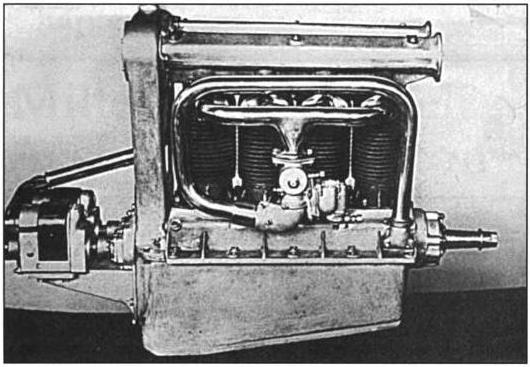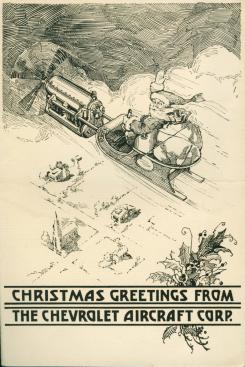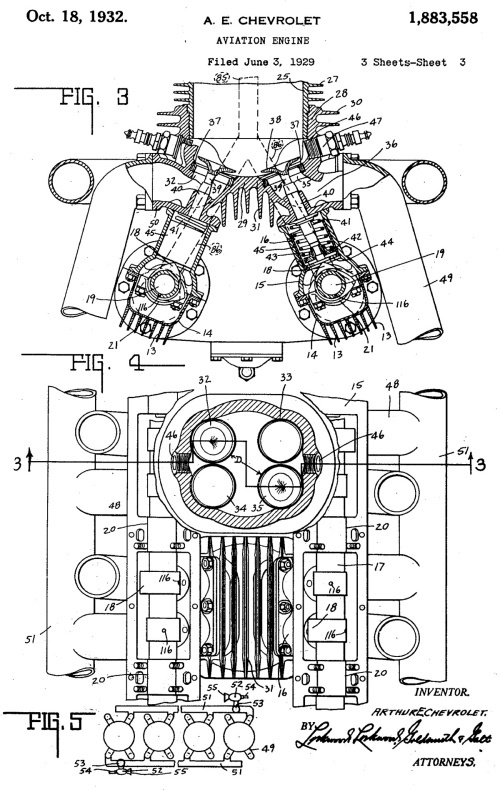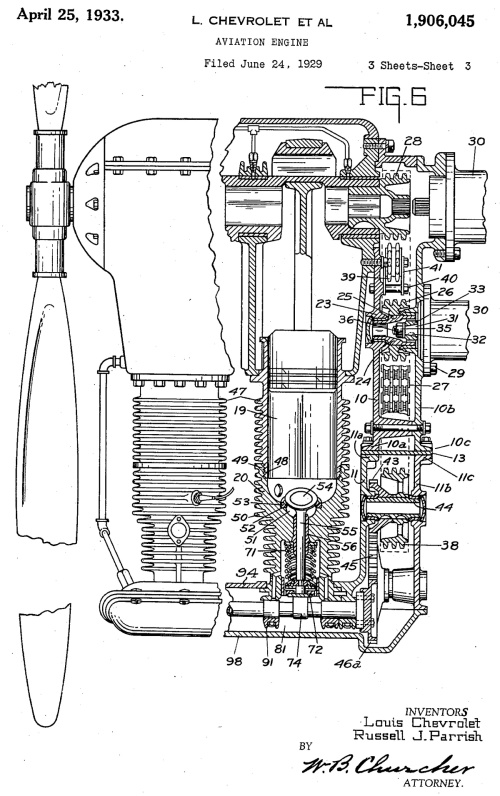

Chevrolet Aircraft Engines
by Billy Dunbar and Kem Robertson
Original 28 Nov 2016
 |
 |
| Arthur Chevrolet’s 1928 Engine (Indianapolis Motor Speedway Collection) | Chevrolet Aircraft Corp Christmas Card that was sent to Harold F Pitcairn when Chevrolet was trying to get an engine to work in a Pitcairn autogiro. (Courtesy Tom Heitzman) |
Louis Chevrolet and his younger brother Arthur built cylinder heads and aftermarket speed equipment for Model T Fords in the 1920s. Around 1925 Louis started taking a deeper interest in aviation, attending air shows in and around the Indianapolis area. In 1926 he entered into negotiations with a group of Ohio businessmen who were looking to develop a new airplane engine. In the spring of 1927, the Chevrolet brothers completed their first aviation engine, an air-cooled, single-overhead-cam, 4-cylinder engine. This engine was installed in a biplane built by the Moundsville Aircraft Corp of West Virginia. There are photos of Charles Lindbergh inspecting the engine in that airplane in the summer of 1927. On the plane's maiden flight, it was forced to make an emergency landing because of engine trouble (thankfully nobody was hurt). The Chevrolet brothers went back to the drawing board, and news of their venture quickly disappeared from the public eye. In late 1927 or early 1928 the brothers had a heated argument, split up, and did not talk to each other for several years to follow. Given the failure of the first aero engine, and the events that took place in early 1928, it would appear that the argument stemmed from the design of their airplane engine. In the spring of 1928, Louis left the Chevrolet Brothers Manufacturing Company and started a new company called the Chevrolet Aircraft Corporation. Louis then spent the next year developing his new engine with Charles Merz (veteran of the 1st Indy 500). Arthur continued working on the old airplane engine, modifying the design, and photos from September 1928 show a similar style engine but with a double overhead cam set up. Art's modified engine design apparently wasn't successful, and he then designed a completely new engine in the spring of 1929 called the Chevolair. The Chevolair was an inverted engine, using four valves per cylinder, with intake and exhaust valves staggered on each side of the cylinder head. The staggered valve pattern necessitated the use of intake and exhaust manifolds on each side of the engine. Art built both a 4-cylinder and a 6-cylinder engine in the summer of 1929. The 6-cylinder was tested by the Bureau of Aeronautics, and it received Approved Type Certificate No. 56 in July 1930. This same 6-cylinder engine was used by Walter Beech in the Travel Air Mystery Ship for the 1929 National Air Races, but it did not perform very well. A 4-cylinder Chevolair engine was used in a Travel Air biplane for some time. A couple of other planes used the Chevolair engine including a Laird Aircraft, and a Robin Aircraft. Art's company lost traction after the stock market crash of 1929, and went into receivership in 1932. Very few Chevolair engines were made, and none are accounted for today. Louis' new engine was similar to Art's design in that it was inverted with crankshaft on top, and cylinder, heads and valve train on the bottom of the assembly. Louis' engine was not as complicated as Art's design, as it used only two valves per cylinder. In late 1928, Louis sold a 90% interest in the Chevrolet Aircraft Corporation to Glenn L. Martin, and he was retained by Mr. Martin to be president of the company. Louis patented his engine in the spring of 1929, and moved to Baltimore in early 1930. Louis' 4-cylinder Model D-333 engine received Approved Type Certificate No. 59 in 1930, and a number of these 4-cylinder engines were produced. (It is also important to note that experimental in-line 6-cylinder, and Vee configurations were also built). The D-333 4-cylinder engine was installed in an interesting variety of aircraft, including biplane, monoplane, seaplane, and even an autogiro. Additionally, there is correspondence in the War Department files that Louis's engine was being considered for use in the TC-14 blimp project. In January of 1931 Martin changed the name of the company to the Glenn L. Martin Motors Corporation, and Louis' title was changed to VP and General Manager. The economic depression was drying up capital, and sales took a nose dive. Louis ultimately resigned from the Martin Company in December of 1931, but he did hold onto his stock. When the Glenn L. Martin Company had its initial Public Offering in 1934, Chevrolet and Martin were the only stockholders of the company, Louis still owning 1,000 shares (Martin half a million shares).In 1939 Martin sold the patent rights, and existing inventory of engines and spare parts to the Phillips Aviation Corporation. A few airplanes that used Louis' engine have survived. A Waco ENF is still around, and it was the original test mule for Louis' engine. A Granville Brothers “Gee Bee Model A” biplane is now in Oregon, and it once had a Chevrolet engine in it. Finally a Martin seaplane has been restored, and is hanging in the Baltimore Museum of Industry (it is the only known aircraft that retains a Chevrolet engine). For a long time there has been confusion regarding these engines, some sources calling Louis’ a Chevolair, and so forth. Likewise there have been misunderstandings over the names of the two different companies. When Louis left his brother Arthur in late 1927, Art retained ownership of the Chevrolet Brothers Manufacturing Company. Louis then filed articles of incorporation for the Chevrolet Aircraft Corporation. In the fall of 1928, Art changed the name of the Chevrolet Brothers Mfg Co to the Chevrolet Aviation Motors Corporation. Complicating matters was the fact that Louis’ contract with Glenn L. Martin called for the exclusive use of the “Chevrolet” name. The brothers then had a hearing before the Indiana Secretary of State over the use of the name. Following that hearing Art changed the name of his company in early 1929 to the Arthur Chevrolet Aviation Motors Corporation. Later that year, the name of Art’s company was changed for a third time to the Chevolair Motors Corporation. Muddying the waters further, Glenn L. Martin (for reasons unknown) changed the name of the Chevrolet Aircraft Corporation to the Glenn L. Martin Motors Corporation in January 1931. |
| Arthur Chevrolet | Louis Chevrolet |

| 
|
| The Chevrolair Aircraft Engines | The Chevrolet-Martin-Phillips Aircraft Engine |

| 
|
| A Chevrolair Aircraft Engine Patent | A Chevrolet-Martin-Phillips Aircraft Engine Patent |
| Chevrolair Model D-4, D-6 Booklet | Chevrolet Model D-333 Brochure |
| Chevrolet Model 333 Assembly Drawing | |
| Chevrolet-333 Booklet | |
| Martin 333 Booklet | |
| Martin 333 Techical Description and Cylinder Design Notes |